Stretching is instinctive, we all do it. We all know that amazing feeling of stretching while yawning… it feels so good!
There are two main types of stretches: Static stretches and Dynamic stretches.
Static stretches are done by standing still and holding a single position for a period of time, up to about 45 seconds.
Dynamic stretches are controlled movements that prepare your muscles, ligaments, and other soft tissues for your run.
According to experts, the action of static stretching is in essence stretching a cold muscle, which is not good for the muscle, and depending on the nature of the stretch can have the opposite to the desired effect.

Static Stretching & Running
Static stretching doesn’t help you warm up in the way that people used to think it does.
Static stretching is essentially stretching your muscle fibers, holding that stretch for a few seconds and then letting those muscle fibers pull back together.
We do not favor static stretching before heading out on a run for 3 main reasons:
- There is very little correlation between static stretching and injury prevention. Even though we have always been taught to do this, there is no proof that static stretching can actually prevent injuries.
- When you are static stretching and pulling those muscle fibers apart, you are not allowing your body to achieve an increase in power production when you are running, this is because those muscle fibers won’t have that elasticity needed to bounce back as much as you would need them to.
- Stretching after exercise is what causes an improvement in flexibility and a reduction in injury risk over time. Stretching before exercise reduces the likelihood of post-exercise stretching.
It is a known fact that runners are creatures of habit and if you have been stretching before running throughout your career then we would encourage a warm-up before stretching.
Impact Of Static Stretching On Running Performance
We see it all the time, runners gathered with their mates in a circle practically STANDING STILL “Loosening up” by doing the good old runner’s quad stretch up…to run faster and prevent muscle strain. When you think about it, it does sound counteractive right?
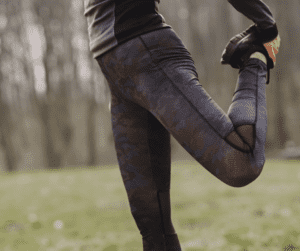
That’s because it is!
Runners don’t actually need that much flexibility.
The ability to do a split or even touch your toes is not an indication that you’re resilient to injuries or have a better running aptitude.
The majority of running injuries occur within one’s normal range of motion of running. A study conducted by the CDC found that static stretching has zero effect on injury rates.
When you are running you need muscle tension to use your legs as ‘springs’. Static stretching will result in a weaker ‘spring’ and therefore a less efficient run. In other words, static stretching reduces your power output on your run.
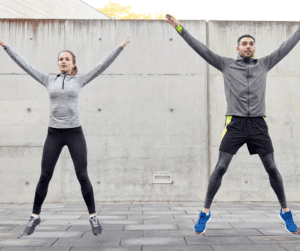
There is one word that runners need to live by when it comes to stretching…
Mobility
If your goal is to sprint, run gracefully over rugged trails, tackle some obstacles and break PB’s then mobility is your new best friend.
If your muscles and joints can’t move through the entire range of motion required with each stride, you won’t run as well as you would like and your risk of injury will increase.
Dynamic stretching and mobility are like two peas in a pod. Dynamic stretching increases joint and muscle mobility.
If mobility is something you struggle with, then grab our free mobility flow that you can do at home by clicking here.
Dynamic Stretching & Running
Dynamic stretching is when your muscle fibers are lengthening, contracting, and expanding over a repetitive movement. It has been recently proven that dynamic stretching increases your power output during your run.
In this video, Brad Brown catches up with our strength & conditioning Coach Shona Hendricks to talk about whether or not stretching will make you a better runner and if so… what should you be doing?
Dynamic stretches are meant to get the body moving and aren’t held for any length of time.
According to this study done by the International Journal Of Sports Physical Therapy, runners will reap more benefits from dynamic stretching compared to static stretching during their run.
We aren’t saying that you should never do static stretches. The best time to do static stretches would be after your run, during your cool down.
How To Stretch Before & After A Run – Safely
A warm-up should consist of some easy running, a few builds, strides, and/or running drills.
(You can grab our free running drills flow by clicking here)
When doing hard training sessions such as intervals, hills, track, or time trials it is important to do a good 15-20min warm-up and to include some dynamic stretching.
For easy, recovery and long runs it is sufficient to start nice and easy for 5-10min before settling into your stride for the rest of the session.
It is still important to maintain flexibility and as such you should aim to spend at least 10min static stretching at the END of each session.
Aim to hold each stretch for a minimum of 30 seconds and try to repeat each stretch twice per limb. Focus muscles should be glutes, hip flexors, hamstrings, and quads. Calf stretches should be gentle stretches.
Regular stretching post-exercise will help to reduce injury risk, particularly to the lower back, ITB and hamstrings.
Now that you know how, what stretches you should be doing & when you should be doing them, let’s have a closer look at some dynamic stretches…
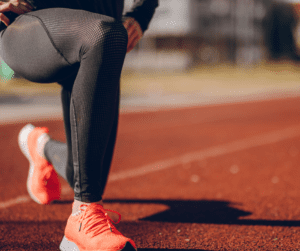
Dynamic Stretches For Runners
Leg Swings
We recommend doing two types of leg swings.
First Type:
What: Forward and back leg swings, this is to activate your hips, quads, hamstrings, and glutes.
How: Start gently, swing your leg forward and back, try to keep your knee as straight as possible. Then, gently increase your range of motion and the tempo at which you are swinging your leg.
Volume: Minimum of 10 swings on each leg, but importantly – listen to your body and do as many as you feel you need. (If your legs are feeling a bit stiff then do more)
Second Type:
What: Leg swings side to side, this is to focus on the abductors, so be gentle with yourself.
How: Gently swing your leg from side to side, across your body, and slowly increase that range of motion as well as the tempo as you go along.
Volume: Minimum of 10 swings on each leg, but importantly – listen to your body and do as many as you feel you need. (If your legs are feeling a bit stiff then do more)
Remember that these are warm-up stretches so while you are doing them you should have good intentions.
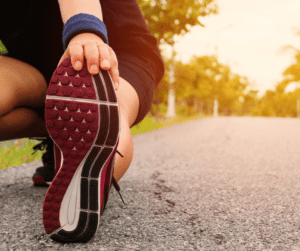
How To Activate Your Glutes
Your glutes are vital for running, they play a massive role in stabilizing the hips.
What: Cross one foot over the other knee and sit yourself down in that position.
How: Hold onto something next to you to help you balance, place your left foot on top of your right knee, now bend into that right knee onto an imaginary chair. Stand up, swap sides and do the same thing on the other side.
Volume: Try not to hold this position into a long static stretch, feel the stretch then move on to the next side. Again, if you feel that your body needs this stretch then spend a bit more time doing it.
(This stretch can be amplified by placing your hand on your knee and applying a gentle push.)
How To Stretch Your Calf Muscles
What: Reciprocated movement of pushing down onto the heel and then forward onto the toes of each foot.
How: Get into the position of leaning slightly forward against a wall or cabinet, your aim should be to get a good range of motion so push up onto the toes of one foot and down onto the heel of the opposite foot, and then reciprocate that movement. Increase the tempo as you do more.
Volume: 15 to 20 on each leg, depending on how your calves are feeling.
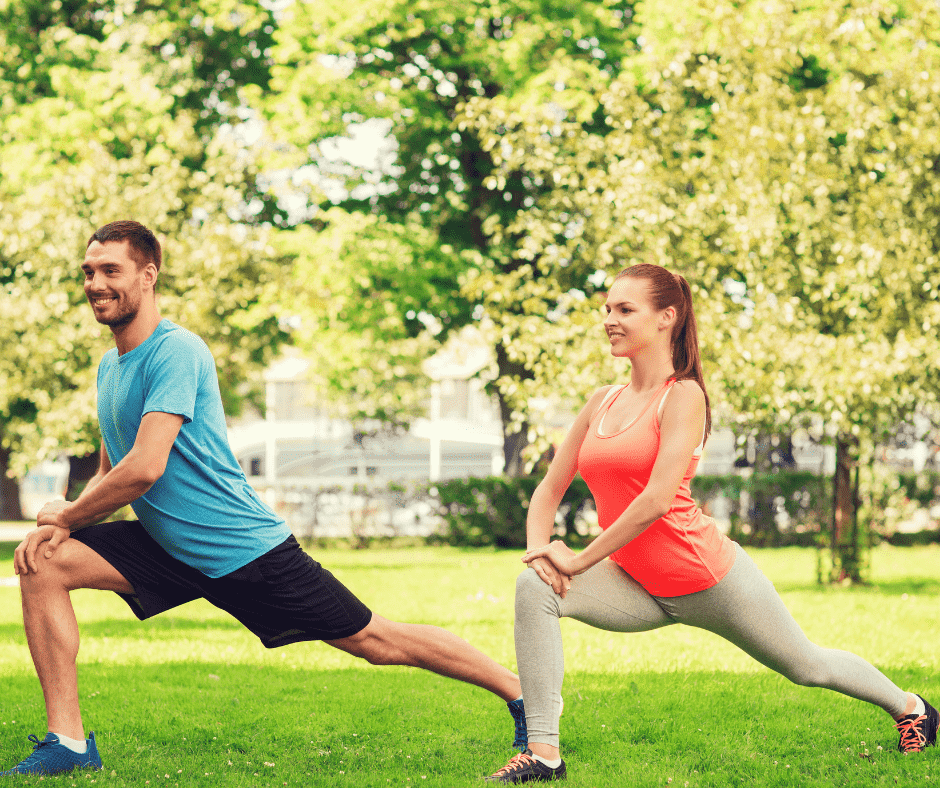
How To Stretch Your Groin & Glutes
What: Knee up to your chest.
How: Stand with your feet hip-distance apart, and bring your right knee up to your chest, whilst doing this motion go up onto your toe on the left foot and vice versa.
Volume: Again, try not to hold this position into a long static stretch, feel the stretch then move on to the next side.
How To Stretch Your Hip Flexors
We recommend that if you do struggle with your knees then you should leave this one out.
What: Warming up the hip flexors with a high knee and lunge.
How: Pull your knee up and into your chest, take a big step forward and lunge down into that position with the leg you pulled into your chest in front of you. Stand up straight and repeat on the other side.
(Be aware: You do not want your front knee to be pushing over your toes)
Volume: 5 lunges on each leg, but importantly – listen to your body and stop if you feel any discomfort in your knees.
View a video demonstration of all the dynamic stretches above here.
If you need some help with stretching, strength, and conditioning, you’ll be pleased to know we’ve got a free strength training plan…. Just for you!


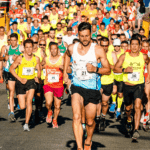
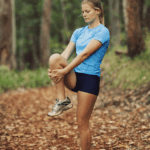
Comments are closed.